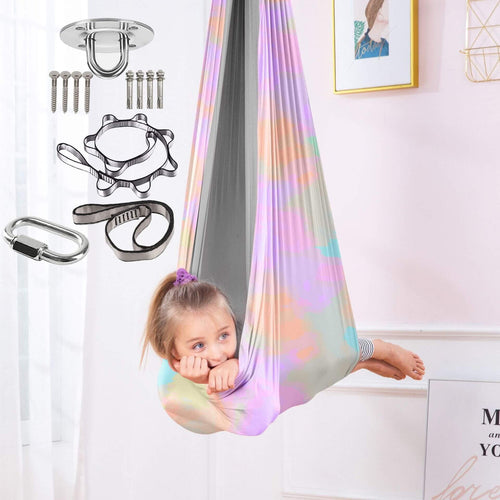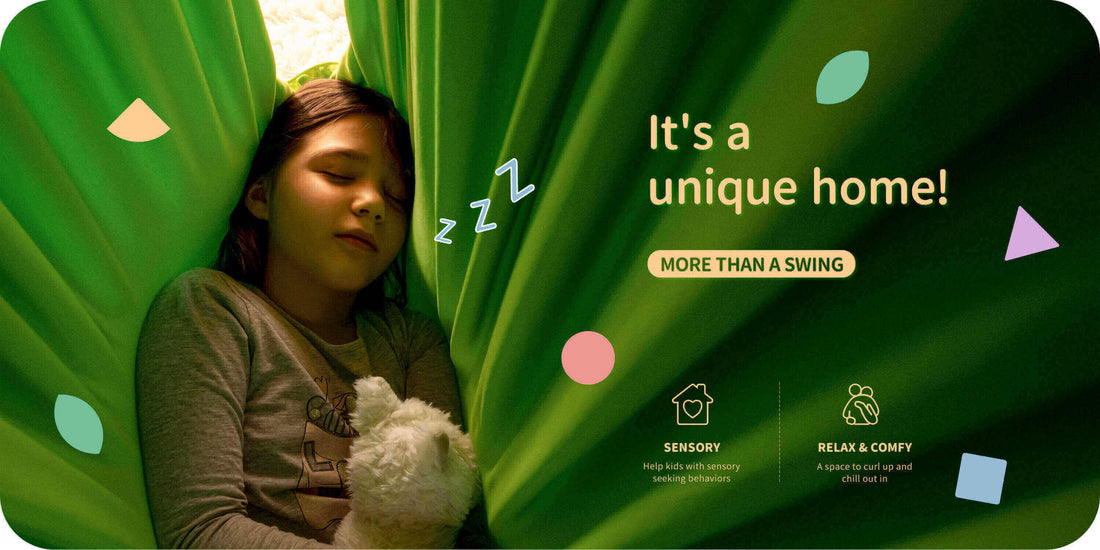Introduction
Sensory swings have emerged as a powerful therapeutic tool in the field of autism therapy. These specialized swings provide sensory input and promote sensory integration, helping children with autism improve their sensory processing skills and overall functioning. In this comprehensive guide, we will explore the benefits of sensory swings in autism therapy and discuss the different types of swings available. We will also delve into the science behind sensory swings and provide practical tips for incorporating them into therapy sessions.
I. Understanding Sensory Swings
Sensory swings are designed to provide sensory input in a controlled and therapeutic manner. They come in various forms, each offering unique benefits and catering to different sensory needs. Some of the most commonly used sensory swings include platform swings, therapy swings, hammock swings, disc swings, adaptive swings, and compression swings.
Platform Swings: Platform swings are versatile swings that provide a large, stable surface for sitting, standing, or lying down. They are particularly beneficial for children who struggle with balance or motor planning. One popular platform swing is the "Sensory Scout Platform Swing," known for its sturdiness, ease of installation, and indoor/outdoor usability.
Therapy Swings: Therapy swings, such as the "InYard Therapy Swing," are specifically designed for sensory integration therapy. Made from stretchy and durable fabric, these swings provide a sense of security and comfort. The pressure from the swing can have a calming effect, making it suitable for children who experience sensory overload.
Hammock Swings: Hammock swings offer a calming retreat for children with autism. The gentle rocking motion and cocoon-like design provide a sense of security. The "Sorbus Kids Child Pod Swing Chair" is a popular choice, featuring soft cotton fabric and an inflatable cushion for added comfort.
Disc Swings: Disc swings, like the "Super Spinner Swing," provide a unique swinging experience. Children can sit or stand on the disc, promoting balance, coordination, and valuable vestibular input.
Adaptive Swings: Adaptive swings are designed for children with special needs, providing additional support and safety features. The "FlagHouse High-Back Swing Seat" stands out with its high back and safety harness. It is also adjustable, allowing it to grow with the child.
Compression Swings: Compression swings, such as the "Harkla Compression Sensory Swing," offer a safe and comfortable space for children to relax and stimulate their senses. Made from a blend of spandex and nylon, this swing provides a hug-like effect due to its compression. It also offers vestibular input, helping children understand their spatial surroundings.
II. The Science Behind Sensory Swings
Numerous academic studies have highlighted the benefits of sensory swings for children with autism. Researchers have found that sensory-based interventions, including the use of sensory swings, can lead to improvements in sensory responsiveness and reductions in anxiety and distress (Ayres, 2005; Baranek et al., 2013; Case-Smith et al., 2015; Schaaf et al., 2014). These interventions, such as sensory integration therapy, aim to help individuals with autism improve their ability to process sensory information and integrate it into their daily lives.
For example, a study by J. Case-Smith and T. Bryan examined the effects of an occupational therapy intervention emphasizing sensory integration on preschool-age children with autism. The results supported the idea that children with autism can make behavioral changes when participating in sensory integration therapy (Case-Smith & Bryan, 2013). Another study by R. Watling and J. Dietz explored the immediate effects of Ayres's sensory integration-based occupational therapy intervention on children with autism spectrum disorders. While the short-term effects did not significantly differ from a play scenario, subjective data suggested that Ayres's sensory integration may produce an effect evident during treatment sessions and in home environments (Watling & Dietz, 2007).
Occupational therapy using sensory integration principles has shown promise in improving participation, adaptive behaviors, and sensory processing in children with autism (Schaaf et al., 2019; Schaaf et al., 2017). These studies highlight the therapeutic potential of sensory swings in autism therapy.
III. Benefits of Sensory Swings in Autism Therapy
Sensory swings offer a range of benefits for children with autism, promoting sensory integration, motor skills, and relaxation. Here are some key advantages of incorporating sensory swings into autism therapy:
-
Sensory Input: Sensory swings provide controlled sensory input, helping children with autism regulate their sensory systems. The swinging motion stimulates the vestibular system, which influences balance and spatial orientation. This input can enhance body awareness, muscle tone, and coordination.
-
Sensory Integration: Sensory swings facilitate the integration of sensory information, allowing children with autism to process and respond to sensory stimuli more effectively. By engaging in swinging activities, they learn to coordinate their movements, improve motor planning skills, and develop a better understanding of their body's position in space.
-
Calming Effect: The rhythmic motion of sensory swings can have a calming effect on children with autism. The predictable and repetitive movements provide a sense of security and help reduce anxiety and stress. This can be particularly beneficial for individuals who experience sensory overload or have difficulty self-regulating.
-
Motor Skills Development: Swinging on sensory swings requires coordination, balance, and motor planning. By engaging in swinging activities, children with autism can improve their motor skills, including bilateral coordination, gross motor coordination, and eye-hand or eye-foot coordination.
-
Sensory Exploration: Sensory swings offer a safe and controlled environment for sensory exploration. Children can engage with different textures, movements, and positions while swinging, enhancing their sensory experiences and promoting sensory integration.
-
Therapeutic Engagement: Sensory swings provide a fun and engaging way for children with autism to participate in therapy sessions. The enjoyable nature of swinging can increase motivation and willingness to participate in therapeutic activities, leading to more effective therapy outcomes.
IV. Incorporating Sensory Swings into Autism Therapy
When incorporating sensory swings into autism therapy, it is essential to consider the individual needs and preferences of each child. Here are some guidelines for using sensory swings effectively in therapy sessions:
-
Assessment: Begin by conducting a comprehensive assessment of the child's sensory needs and preferences. This assessment should include an evaluation of their sensory processing difficulties, motor skills, and therapeutic goals. Collaborate with the child's occupational therapist to ensure a tailored approach.
-
Swing Selection: Choose a sensory swing that aligns with the child's sensory preferences and therapy goals. Consider factors such as the type of swing, swinging movements, material, and safety features. The chosen swing should provide the appropriate sensory input and promote the desired therapeutic outcomes.
-
Safety Precautions: Ensure that the sensory swing is installed correctly and meets safety standards. Regularly inspect the swing for any signs of wear and tear, and make necessary adjustments or replacements as needed. Adult supervision is crucial during swing sessions to ensure the child's safety.
-
Structured Activities: Plan structured activities that incorporate the use of the sensory swing. These activities should target specific therapeutic goals, such as motor skills development, sensory integration, or relaxation. Work closely with the child's occupational therapist to design activities that are appropriate for their individual needs.
-
Gradual Progression: Introduce swinging activities gradually, starting with slower and more predictable movements. Monitor the child's response and gradually increase the intensity or complexity of the swinging motions as they become more comfortable and regulated. Pay attention to any signs of overstimulation or dysregulation and adjust the swing activities accordingly.
-
Therapist Guidance: As the occupational therapist, provide guidance and support to the child during swing sessions. Offer verbal cues, prompts, or physical assistance as needed to ensure proper positioning, engagement, and safety. Encourage the child to actively participate and provide positive reinforcement for their efforts.
By following these guidelines, occupational therapists can effectively incorporate sensory swings into autism therapy and maximize the therapeutic benefits for children with autism.
V. Conclusion
Sensory swings have revolutionized autism therapy, providing a valuable tool for sensory input, sensory integration, and overall well-being. These swings offer a range of benefits for children with autism, promoting sensory processing skills, motor development, and relaxation. By understanding the science behind sensory swings and incorporating them into therapy sessions, occupational therapists can help children with autism thrive and reach their full potential. Remember, each child is unique, and finding the right sensory swing and therapeutic approach requires careful assessment, collaboration, and ongoing evaluation. Let the power of sensory swings unlock the therapeutic potential for children with autism in their journey towards optimal sensory integration and well-being.







